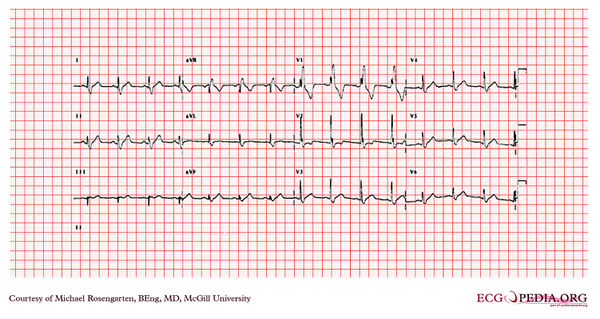McGill Case 196: Difference between revisions
Jump to navigation
Jump to search

(Created page with "{{McGillcase| |previouspage= McGill Case 197 |previousname= McGill Case 197 |nextpage= McGill Case 198 |nextname= McGill Case 198 }} [[File:E196.jpg|thumb|600px|left|This car...") |
No edit summary |
||
| Line 1: | Line 1: | ||
{{McGillcase| | {{McGillcase| | ||
|previouspage= McGill Case | |previouspage= McGill Case 195 | ||
|previousname= McGill Case | |previousname= McGill Case 195 | ||
|nextpage= McGill Case | |nextpage= McGill Case 197 | ||
|nextname= McGill Case | |nextname= McGill Case 197 | ||
}} | }} | ||
[[File:E196.jpg|thumb|600px|left|This cardiogram shows sinus rhythm with a normal pr interval and a prolonged QRS interval (>120ms). There is a conduction abnormality best described as a right bundle branch block due to the rsR' wave in V1. Note the S wave in V6 which is due to the RBBB is smaller than the R wave in V6. The axis of the QRS is difficult to determine, but one usually looks at the first 60 ms. (1 1/2 small squares) to determine the axis with a RBBB. If the axis of the first 60 ms. of the QRS is more than 90 degrees and there is an rS in lead I and a Q in lead III then on would consider a left posterior fasicular block. This is not the case here. | [[File:E196.jpg|thumb|600px|left|This cardiogram shows sinus rhythm with a normal pr interval and a prolonged QRS interval (>120ms). There is a conduction abnormality best described as a right bundle branch block due to the rsR' wave in V1. Note the S wave in V6 which is due to the RBBB is smaller than the R wave in V6. The axis of the QRS is difficult to determine, but one usually looks at the first 60 ms. (1 1/2 small squares) to determine the axis with a RBBB. If the axis of the first 60 ms. of the QRS is more than 90 degrees and there is an rS in lead I and a Q in lead III then on would consider a left posterior fasicular block. This is not the case here. | ||
]] | ]] | ||
Latest revision as of 11:39, 19 February 2012
| This case report is kindly provided by Michael Rosengarten from McGill and is part of the McGill Cases. These cases come from the McGill EKG World Encyclopedia.
|

This cardiogram shows sinus rhythm with a normal pr interval and a prolonged QRS interval (>120ms). There is a conduction abnormality best described as a right bundle branch block due to the rsR' wave in V1. Note the S wave in V6 which is due to the RBBB is smaller than the R wave in V6. The axis of the QRS is difficult to determine, but one usually looks at the first 60 ms. (1 1/2 small squares) to determine the axis with a RBBB. If the axis of the first 60 ms. of the QRS is more than 90 degrees and there is an rS in lead I and a Q in lead III then on would consider a left posterior fasicular block. This is not the case here.
